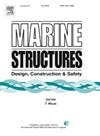Progressive collapse response and ultimate strength evaluation of stiffened plates with welding residual stress under combined biaxial cyclic loads and lateral pressure
IF 4
2区 工程技术
Q1 ENGINEERING, CIVIL
引用次数: 0
Abstract
Stiffened plates used in bottom structures of ships are commonly subjected to multiaxial loading in harsh sea state. Thus, understanding their collapse behaviour under combined loads is highly valuable, and numerical simulations can provide accurate insights into this topic. The current research is the first to deal with the ultimate strength characteristics and assessment of initially deflected stiffened plates with welding residual stress (WRS) under combined biaxial cyclic loads and lateral pressure. Finite element analysis is conducted extensively to obtain the numerical results of longitudinal cyclic ultimate strength considering geometric and material nonlinearities with the aid of secondary development of ABAQUS software. It is found that the cyclic ultimate strength is governed by the coupling effects of structural dimensions, longitudinal and transverse residual stresses as well as transverse cyclic compressive/tensile loads and lateral pressure. A series of significant findings observed from this paper are presented in detail aiming to improve the ultimate limit state (ULS) design of ship structures. Based on sufficient sample points, four different machine learning (ML) models are trained maturely to predict the cyclic ultimate strength, including back propagation neural network (BPNN), support vector regression (SVR), random forest (RF) and radial basis function (RBF) network. Performance of these models is compared objectively using statistical metrics.
焊接残余应力加劲板在双轴循环载荷和侧压力联合作用下的渐进坍塌响应和极限强度评估
用于船底结构的加劲板在恶劣海况下通常会承受多轴载荷。因此,了解它们在组合载荷作用下的坍塌行为非常有价值,而数值模拟可以为这一课题提供准确的见解。目前的研究首次涉及焊接残余应力(WRS)的初始偏转加劲板在组合双轴循环载荷和侧压力下的极限强度特性和评估。在 ABAQUS 软件二次开发的帮助下,考虑到几何和材料非线性因素,进行了广泛的有限元分析,以获得纵向循环极限强度的数值结果。分析发现,循环极限强度受结构尺寸、纵向和横向残余应力以及横向循环压缩/拉伸载荷和侧压力的耦合效应制约。本文详细介绍了一系列重要发现,旨在改进船舶结构的极限状态(ULS)设计。基于足够的样本点,对四种不同的机器学习(ML)模型进行了成熟的训练,以预测循环极限强度,包括反向传播神经网络(BPNN)、支持向量回归(SVR)、随机森林(RF)和径向基函数(RBF)网络。使用统计指标对这些模型的性能进行了客观比较。
本文章由计算机程序翻译,如有差异,请以英文原文为准。
求助全文
约1分钟内获得全文
求助全文
来源期刊

Marine Structures
工程技术-工程:海洋
CiteScore
8.70
自引率
7.70%
发文量
157
审稿时长
6.4 months
期刊介绍:
This journal aims to provide a medium for presentation and discussion of the latest developments in research, design, fabrication and in-service experience relating to marine structures, i.e., all structures of steel, concrete, light alloy or composite construction having an interface with the sea, including ships, fixed and mobile offshore platforms, submarine and submersibles, pipelines, subsea systems for shallow and deep ocean operations and coastal structures such as piers.
 求助内容:
求助内容: 应助结果提醒方式:
应助结果提醒方式:


